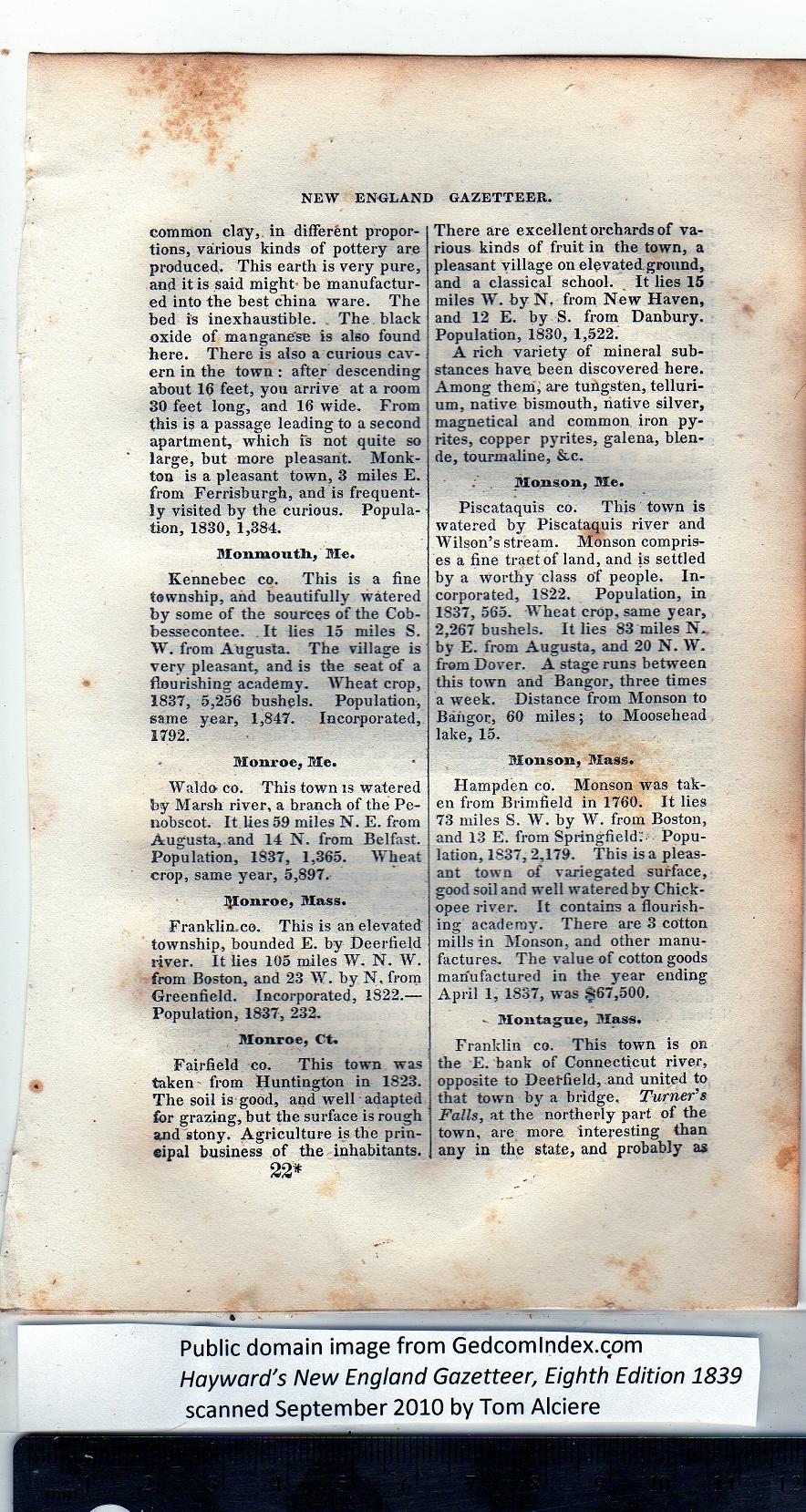|
common clay, in different propor-
tions, various kinds of pottery are
produced. This earth is very pure,
and it is said might- be manufactur-
ed into the best china ware. The
bed is inexhaustible. . The black
oxide of manganese is also found
here. There is also a curious cav-
ern in the town : after descending
about 16 feet, you arrive at a room
30 feet long, and 16 wide. From
this is a passage leading to a second
apartment, which fs not quite so
large, but more pleasant. Monk-
ton is a pleasant town, 3 miles E.
from Ferrisburgh, and is frequent-
ly visited by tbe curious. Popula-
tion, 1830, 1,384.
Monmouth, Me.
Kennebec co. This is a fine
township, and beautifully watered
by some of the sources of the Cob-
bessecontee. It lies 15 miles S.
W. from Augusta. The village is
very pleasant, and is the seat of a
flourishing academy. Wheat crop,
1837, 5,256 bushels. Population,
same year, 1,847. Incorporated,
1792.
Monroe, Me.
Waldo co. This town 13 watered
by Marsh river, a branch of the Pe-
nobscot. It ties 59 miles N. E. from
Augusta, and 14 N. from Belfast.
Population, 1S37, 1,365. Wheat
crop, same year, 5,897.
^lonroe, Mass.
Franklin.ce. This is an elevated
township, bounded E. by Deerfield
river. It ties 105 miles W. N. W.
from Boston, and 23 W. by N. from
Greenfield. Incorporated, 1822.—
Population, 1837, 232.
Monroe, Ct.
Fairfield co. This town was
taken from Huntington in 1823.
The soil is good, and well adapted
for grazing, but tbe surface is rough
and stony. Agriculture is the prin-
cipal business of the inhabitants.
22* |
There are excellent orchards of va-
rious kinds of fruit in the town, a
pleasant village on elevated ground,
and a classical school. It lies 15
miles W. by N. from New Haven,
and 12 E. by S. from Danbury.
Population, 1830, 1,522.
A rich variety of mineral sub-
stances have been discovered here.
Among them, are tungsten, telluri-
um, native bismouth, native silver,
magnetical and common iron py-
rites, copper pyrites, galena, blen-
de, tourmaline, &c.
Monson, Me.
Piscataquis co. This town is
watered by Piscataquis river and
Wilson’s stream. Monson compris-
es a fine traetof land, and is settled
by a worthy class of people. In-
corporated, 1822. Population, in
1S37, 565. Wheat crop, same year,
2,267 bushels. It lies 83 miles N.
by E. from Augusta, and 20 N. W.
from Dover. A stage runs between
this town and Bangor, three times
a week. Distance from Monson to
Bangor, 60 miles; to Moosehead
lake, 15.
Monson, Mass.
Hampden co. Monson was tak-
en from Brimfield in 1760. It lies
73 miles S. W. by W. from Boston,
and 13 E. from Springfield'.'• Popu-
lation, 1837,2,179. This is a pleas-
ant town of variegated surface,
good soil and well watered by Chick-
opee river. It contains a flourish-
ing academy. There are 3 cotton
mills in Monson, and other manu-
factures. The value of cotton goods
manufactured in the year ending
April 1, 1837, was §67,500,
- Montague, Mass.
Franklin co. This town is on
the E. bank of Connecticut river,
opposite to Deerfield, and united to
that town by a bridge. JVrner’s
Falhy at the northerly part of the
town, are more interesting than
any in the state, and probably as |
